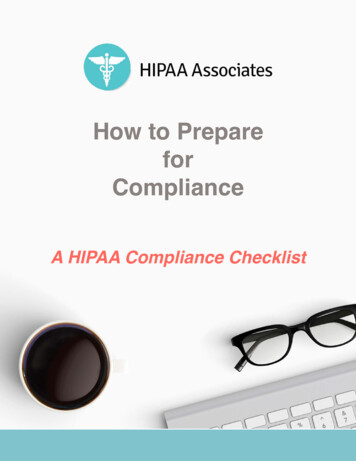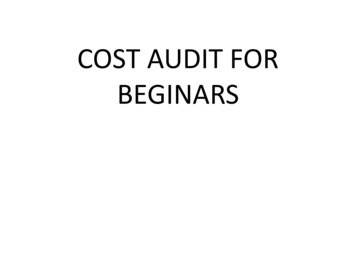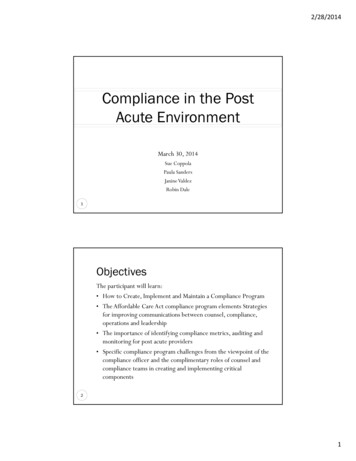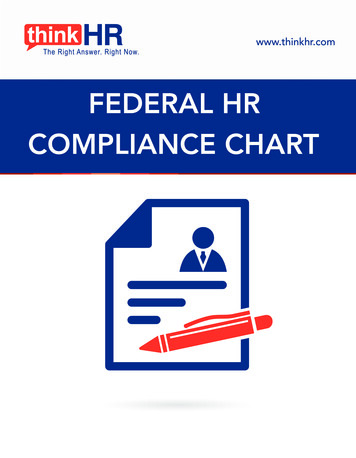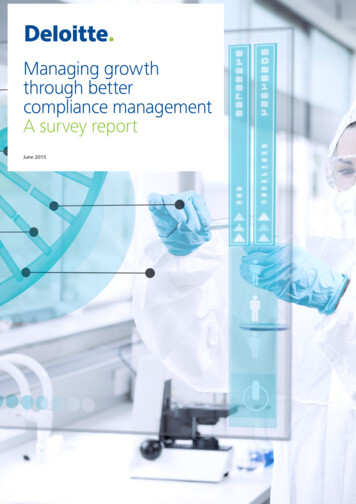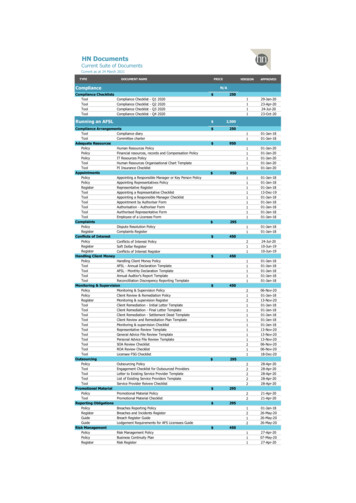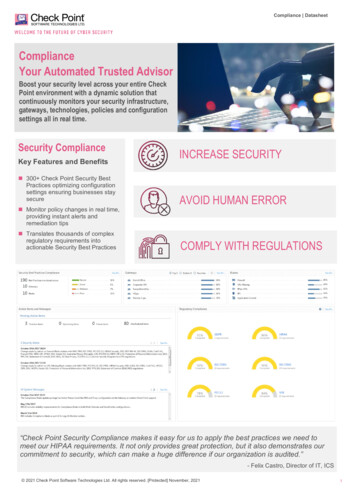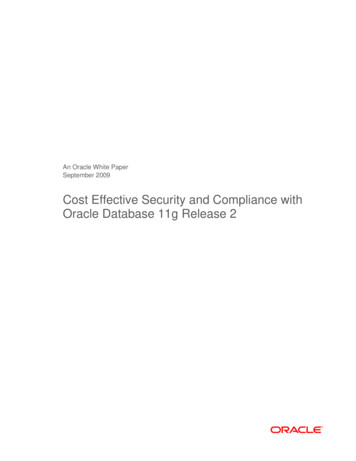
Transcription
An Oracle White PaperSeptember 2009Cost Effective Security and Compliance withOracle Database 11g Release 2
Oracle White Paper—Cost Effective Security and Compliance with Oracle Database 11g Release 2Introduction . 1Defense-in-Depth Security . 2Oracle’s Defense-in-Depth Security Solution . 3Encryption and Masking. 4Access Control . 4Monitoring . 4Encryption and Masking. 4Transparent Data Encryption . 4Encryption For Data In Transit . 5Protecting Your Backup Tapes . 5Oracle Data Masking. 6Access Control . 6Privileged User Control . 6Real Time Access Controls. 7Separation of Duty . 7Data Classification . 8Monitoring . 9Configuration Management Pack for Compliance. 9Compliance Assessments . 9Monitoring User Activities. 10Data History and Retention . 12Conclusion . 13
Oracle White Paper—Cost Effective Security and Compliance with Oracle Database 11g Release 2IntroductionInformation ranging from trade secrets to financial data to privacy related information hasbecome the target of sophisticated attacks from both sides of the firewall. While mostorganizations have deployed firewall, intrusion detection, and anti-spam technologies,protecting data now requires a defense-in-depth strategy that enables both preventiveand detective controls to enforce security principles such as need-to-know and trust-butverify. Built upon 30 years of security experience, the Oracle database provides defensein-depth security controls that enable organizations to transparently protect data. Byleveraging these controls, organizations can safeguard data, ensure regulatorycompliance, and achieve business goals such as consolidation, globalization, rightsourcing and cloud computing while still maintaining scalability, performance andavailability.Figure 1. Privacy and Regulatory Compliance1
Oracle White Paper—Cost Effective Security and Compliance with Oracle Database 11g Release 2Defense-in-Depth SecurityDefense-in-depth data security means looking at data security holistically. To do that, one needsto look at the entire life cycle of the data, where the data resides, what applications access thedata, who is accessing the data and under what conditions, and ensuring that the systems havebeen properly configured and remain that way. Three key elements of this approach areEncryption and Data Masking, Access Control, and Monitoring:Figure 2. Defense-in-DepthEncryption and masking are important for protecting data outside the access control perimeterof the database. Data sitting on disk underneath the database and applications, data in test anddevelopment environments, data traveling over the network and data on backup media needsprotection that only encryption and masking can offer. Discarded disk drives and the presenceof super users on the operating system leave open the possibility of unimpeded access tosensitive data that bypasses the authentication and access controls within the database.Movement of production data to other departments for testing and development purposesunnecessarily exposes sensitive data to individuals without a true “need-to-know”. Mostcertainly, data traveling over the wire is perhaps the most at risk of unauthorized access.Access controls beyond the application level are now vital to enabling organization to achieve thebenefits of data consolidation, off-shoring and cloud computing. Historically applications have2
Oracle White Paper—Cost Effective Security and Compliance with Oracle Database 11g Release 2been designed to scale to Internet requirements and provide role based functional access. Today,however, regulations and privacy laws require limited access to application data, even by thedatabase administrator and especially from ad-hoc tools that can be used to bypass theapplication.While encryption and access control are key components to protecting data, even the bestsecurity systems are not complete without a monitoring system in place. Just as video camerassupplement audible alarms in homes and businesses, monitoring provides the correspondingwho, what and when that complements the encryption, masking and access control systems.Oracle’s Defense-in-Depth Security SolutionOracle provides a comprehensive and transparent defense-in-depth solutions to meet thechallenges associated with business initiatives and the complex regulatory environment found intoday’s global economy.Figure 3. Oracle’s Defense-in-Depth Solution3
Oracle White Paper—Cost Effective Security and Compliance with Oracle Database 11g Release 2Encryption and Masking Oracle Advanced Security provides Transparent Encryption of stored data and data in transit. Oracle Secure Backup is a tape backup solution that encrypts databases and file system data. Oracle Data Masking de-identifies production data before transferring to test or partners.Access Control Oracle Database Vault provides access control over administrative and privileged users, andreal-time controls over database activity. Oracle Label Security provides data classification based access control.Monitoring Oracle Enterprise Manager’s Configuration Management scans the database and the file systemfor security related configuration settings. Oracle Audit Vault consolidates audit data from multiple servers to keep track of the useractivity; creating reports and alerts on suspicious activity. Oracle Total Recall provides a history of changes to sensitive data.Encryption and MaskingTransparent Data EncryptionOracle provides robust encryption solutions to safeguard sensitive data against unauthorizedaccess at the operating system level or through theft of hardware or backup media. OracleAdvanced Security transparent data encryption (TDE) addresses privacy and PCI requirementsby encrypting personally identifiable information such as social security numbers and credit cardnumbers. Oracle supports transparently encrypting specific sensitive columns with TDE columnencryption or encrypting entire applications with TDE tablespace encryption. Using OracleEnterprise Manager, a column can be quickly and easily encrypted or an entire encryptedtablespace can be created to store all application tables. TDE is completely transparent toexisting applications and does not require any triggers, views or other application changes.4
Oracle White Paper—Cost Effective Security and Compliance with Oracle Database 11g Release 2Figure 4. Oracle Encryption and Strong AuthenticationData is transparently encrypted when written to disk and transparently decrypted after anapplication user has successfully authenticated, and passed all authorization checks. Existingdatabase backup routines continue to work, with the data remaining encrypted in the backup.For encryption of entire database backups, TDE can be used in combination with Oracle RMANto encrypt backups to disk. Both TDE column encryption and TDE tablespace encryption havebeen certified with Siebel, PeopleSoft, and Oracle E-Business Suite applications.Oracle Database 11g additionally supports storing the TDE master encryption key externally ona hardware security module (HSM) device using the industry standard PKCS#11 interface. Thisprovides an even higher level of assurance for protecting the TDE master key.Encryption For Data In TransitOracle Advanced Security provides an easy-to-deploy solution for protecting all communicationto and from the Oracle Database, providing both SSL/TLS based encryption and native networkencryption for enterprises without a PKI infrastructure. The Oracle database can be configuredto reject connections from clients that do not encrypt data, or optionally allow unencryptedconnections for deployment flexibility. Configuration of network security is simplified using theOracle Network Configuration administration tool, allowing businesses to easily deploy networkencryption without requiring any changes in the application.Protecting Your Backup TapesLost or stolen tapes are frequently the cause for losing sensitive data. Oracle Secure Backupencrypts tapes and provides centralized tape backup management for the entire Oracleenvironment and protects Oracle database, and the associated UNIX, Linux, Windows andNetwork Attached Storage (NAS) file system data. Oracle Secure Backup integrates with Oracledatabase through Recovery Manager (RMAN) supporting versions Oracle Database 9i to Oracle5
Oracle White Paper—Cost Effective Security and Compliance with Oracle Database 11g Release 2Database 11g. With its optimized integration, it achieves faster backups than comparable mediamanagement utilities with less CPU utilization.Oracle Data MaskingOracle Data Masking helps organizations comply with data privacy and protection mandates.With Oracle Data Masking, sensitive information such as credit card or social security numberscan be replaced with realistic but non-factual values, allowing production data to be safely usedfor development, testing, or sharing with out-source or off-shore partners for other nonproduction purposes. Oracle Data Masking uses a library of templates and format rules,consistently transforming data in order to maintain referential integrity for applications.Figure 5. Oracle Data MaskingAccess ControlThe Oracle Database provides powerful abilities to grant and revoke permissions to databaseobjects to users and roles. However in light of new threats and challenges, customers nowrequire separation-of-duty even for administrators, real-time access control on who can do whaton the databases, and the ability to deploy such solutions on existing applications.Privileged User ControlIT administrators, database administrators, and application administrators fill highly trustedpositions within the enterprise. However, regulatory compliance, outsourcing, applicationconsolidation and increasing concerns over insider threats have resulted in an almost mandatoryrequirement for strong controls on access to sensitive application data. With Oracle DatabaseVault, enterprises can prevent privileged users from accessing application data by putting thesensitive tables or application data in a realm. The administrators can continue doing theirperformance tuning and other database management tasks but are prevented from looking ormodifying the sensitive data.6
Oracle White Paper—Cost Effective Security and Compliance with Oracle Database 11g Release 2Figure 6. Privileged User ControlsReal Time Access ControlsOracle Database Vault significantly tightens security by limiting who, when, where and howdatabases, data and applications can be accessed. Multiple factors such as IP address, time of dayand authentication method can be used in a flexible and adaptable manner to enforce accesscontrol without making changes to the application. For example, access can be restricted to aspecific middle tier, creating a “trusted-path” to the application data and preventing use of adhoc tools. Oracle Database Vault can be used to enable additional security policies for mostSQL commands.Figure 7. Real Time Access ControlsSeparation of DutyOracle Database Vault provides three distinct responsibilities out-of-the-box for security;administration, account management, and day-to-day database administration activities. Forexample, Oracle Database Vault can block a DBA from creating a new user if the DBA doesn'thave the proper responsibility. Organizations with limited resources can setup multiple accountsand still benefit from the separation-of-duty enforcement provided by Database Vault. Oracle7
Oracle White Paper—Cost Effective Security and Compliance with Oracle Database 11g Release 2Database Vault is available for Oracle 9i Release 2, Oracle Database 10g Release 2 and OracleDatabase 11g. Out-of-the-box policies are available for many applications including Oracle EBusiness Suite, PeopleSoft, Siebel, JD Edwards EnterpriseOne and SAP.Data ClassificationOracle Label Security protects sensitive data by assigning a data label or data classification toeach row in an application table. Oracle Label Security mediates access by comparing the datalabel against the label of the user requesting access. For transparency, the data label can beappended to the existing application table using a hidden column. Based on the policy of theorganization, data labels can be defined to enforce a combination of hierarchical, compartmentaland group access controls. High security organizations use Oracle Label Security tocompartmentalize access to Sensitive and Highly Sensitive data stored in the same applicationtable, commonly referred to as multi-level security (MLS). Commercial organizations can usedata labels to securely consolidate sensitive data, compartmentalize data for multi-tenancy,hosting, software-as-a-service and other security requirements.Figure 8. Oracle Label SecurityUser labels can be used as factors within Oracle Database Vault command rules. This powerfulcapability extends Oracle Label Security concepts beyond traditional row level access controls tothe database and application level. For example, separation-of-duty can be customized bylooking at an administrator’s user label within a Oracle Database Vault command rule. OracleLabel Security administration can be performed using Oracle Enterprise Manager or thecommand line API. Oracle Label Security is integrated with Oracle Identity Management forenterprise wide management of data and user labels. Oracle Label Security can be used withexisting applications including Oracle E-Business Suite.8
Oracle White Paper—Cost Effective Security and Compliance with Oracle Database 11g Release 2MonitoringConfiguration Management Pack for ComplianceConfiguration management is a critical component in every enterprise's day-to-day IT operations.Oracle Configuration Management Pack forms the centerpiece of Oracle Enterprise Manager’sability to manage configurations and automate IT processes. A key component of this solution isConfiguration Change Console, which reduces cost and mitigates risk by automatically detecting,validating and reporting on authorized and unauthorized configuration changes.Compliance AssessmentsProactive assessment of key compliance areas such as, security, configuration and storage helpidentify areas of vulnerabilities and areas where best practices are not being followed. OracleConfiguration Management Pack ships with over 200 built-in policy checks and the capability foradministrator’s to define their own custom policies.Oracle Configuration Management Pack tracks violations of these policies in a similar manner asperformance metrics. Notification rules can be applied and corrective actions can be assigned toviolations. For example, if a well-known username/password is present in a database, or if anopen port is detected in the Application Server, a corrective action could be defined toautomatically disable the account and close that port.Such proactive enforcement is supplemented with compliance reports. These reports denote thecompliance score for targets. It is possible to view the compliance score over time, along withdrilling down into the violations and impact for each target. Integration with problem ticketingsolutions allow for policy violation information to be automatically sent to a ticketing system andincident tickets created without the need for manual intervention. The compliance dashboardenables administrators to have a quick view of how their systems comply with best securitypractices, and it allows them to drill down into the details. They can also see the historical trendand thus track progress towards compliance over time.9
Oracle White Paper—Cost Effective Security and Compliance with Oracle Database 11g Release 2Figure 9. Configuration ScanningMonitoring User ActivitiesTo comply with SOX, PCI-DSS and other regional privacy directives, businesses not only haveto protect sensitive information, but also monitor access to sensitive information for bothcompliance and potential threats. Examination of numerous data breaches has shown thatauditing could have helped detect problems early, reducing the financial impact.Auditing the privileged and administrative user is an essential part of a defense-in-depth strategy.However, the use of audit data today as a security resource remains very much a manual process,requiring IT security and audit personnel to sift through large amounts of dispersed audit data.Oracle Audit Vault reduces the cost and complexity of compliance and helps detect suspiciousactivity by transparently collecting and consolidating the audit data providing valuable insightinto who did what to which data when – including privileged users who have direct access to thedatabase.With Oracle Audit Vault reports, alert notifications, and centralized audit policy management, therisks from internal threats and the cost of compliance are greatly reduced. Oracle Audit Vaultleverages Oracle's industry leading database security and data warehousing technology formanaging, analyzing, storing, and archiving large volumes of audit data.10
Oracle White Paper—Cost Effective Security and Compliance with Oracle Database 11g Release 2Oracle Audit Vault provides standard audit assessment reports covering privileged users, accountmanagement, roles and privileges, object management and system management across theenterprise. Parameter driven reports can be defined such as showing user login activity acrossmultiple systems and within specific time periods, such as weekends. Oracle Audit Vaultprovides an open audit warehouse schema that can be accessed from Oracle BI Publisher, or 3rdparty reporting tools.Figure 10. Oracle Audit VaultOracle Audit Vault event alerts help mitigate risk and protect from the insider threats byproviding proactive notification of suspicious activity across the enterprise. Oracle Audit Vaultcontinuously monitors the inbound audit data, evaluating audit data against alert conditions.Alerts can be associated with any auditable database event including system events such aschanges to application tables, role grants, and privileged user creation on sensitive systems.11
Oracle White Paper—Cost Effective Security and Compliance with Oracle Database 11g Release 2Figure 11. Oracle Audit Vault ReportsOracle Audit Vault collects database audit data from Oracle9i and higher databases as well asSQL Server 2000 and 2005 releases, Sybase ASE 12.5 - 15.0 and IBM DB2 8.2 and 9.5 databases.Data History and RetentionRegulatory and compliance regulations such as SOX, HIPAA and BASEL–II require retention ofhistorical data. Additionally, businesses are increasingly realizing the immense value historicaldata can provide in terms of helping them understand market trends and customer behavior.Organizations need an efficient mechanism to retain data for longer duration that doesn’t involveapplication rewrites, 3rd party or handcrafted software solutions, and additional administrativeoverheads. Total Recall in Oracle Database 11g addresses these challenges by ensuring complete,secure retention and management of all your historic data. Total Recall with the underlyingtechnology, Flashback Data Archive transparently tracks changes to database tables data in ahighly secure and efficient manner without requiring use of special interfaces or applicationchanges.12
Oracle White Paper—Cost Effective Security and Compliance with Oracle Database 11g Release 2ConclusionTransparent security solutions are critical in today's global business economy due to the cost andcomplexity of modifying existing application’s code. Addressing regulatory compliance andreducing the risk of insider threats requires strong security on application data. Oracle DatabaseSecurity products are designed to work transparently, minimizing any impact on existingapplications while addressing requirements found in many regulations. Oracle database securityproducts provide defense-in-depth security by addressing the three layers of security: encryption& masking, access control, and monitoring.Oracle Advanced Security continues to lead the encryption industry and provides an elegantsolution for protection of privacy related information and compliance with regulations such asPCI. Oracle Advanced Security with Oracle Database 11g introduced tablespace encryption andintegration with hardware security modules, enabling encryption of entire applications andcentralized storage of TDE master encryption keys. Oracle Data Masking enables testers,developers, and partners to access the same production data but only after the sensitive data hasbeen de-identified.Oracle Database Vault transparently addresses the strong internal control requirements found inSOX, PCI, HIPAA, and many other regulations. Oracle Database Vault realms prevent even theDBA from accessing sensitive financial or privacy related information found in applications.Oracle Label Security enables secure consolidation of sensitive data using data labels and userlabels.Oracle Enterprise Manager Configuration Management pack continuously monitors hosts anddatabases for violations of security and configuration best practices, greatly simplifying the job ofthe security administrator. Oracle Audit Vault turns audit data into a key security resource,transparently consolidating and securing vital audit information associated with database activity.Oracle Audit Vault reports, alerts, and policies expedite the job of audit compliance personneland security officers.Protecting data against sophisticated attacks is a challenging task, but Oracle’s defense-in-depthsecurity technology makes the task easier with its transparent and performant solutions.13
Cost Effective Security and Compliance withOracle Database 11g Release 2September 2009Author: Paul NeedhamOracle CorporationWorld Headquarters500 Oracle ParkwayRedwood Shores, CA 94065U.S.A.Copyright 2009, Oracle and/or its affiliates. All rights reserved. This document is provided for information purposes only andthe contents hereof are subject to change without notice. This document is not warranted to be error-free, nor subject to any otherwarranties or conditions, whether expressed orally or implied in law, including implied warranties and conditions of merchantability orfitness for a particular purpose. We specifically disclaim any liability with respect to this document and no contractual obligations areformed either directly or indirectly by this document. This document may not be reproduced or transmitted in any form or by anymeans, electronic or mechanical, for any purpose, without our prior written permission.Worldwide Inquiries:Oracle is a registered trademark of Oracle Corporation and/or its affiliates. Other names may be trademarks of their respectivePhone: 1.650.506.7000owners.Fax: 1.650.506.7200oracle.com0109
Oracle White Paper—Cost Effective Security and Compliance with Oracle Database 11g Release 2 Encryption and Masking Oracle Advanced Security provides Transparent Encryption of stored data and data in transit. Oracle Secure Backup is a tape backup solution that encrypts databases and file system data. Oracle Data Masking de-identifies production data before transferring to test or .


